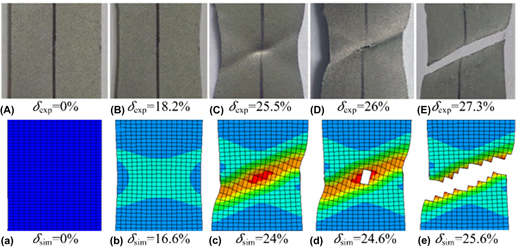Crossref Citations
This article has been cited by the following publications. This list is generated based on data provided by
Crossref.
Li, Chong
E, Daxin
Zhang, Jingwen
and
Yi, Ning
2017.
Investigation of the Geometry of Metal Tube Walls after Necking in Uniaxial Tension.
Metals,
Vol. 7,
Issue. 3,
p.
100.
Ueji, Rintaro
and
Inoue, Tadanobu
2019.
Effect of Interface Morphology on Tensile Properties of Carbon Steel Sheet with Sandwich Structure.
steel research international,
Vol. 90,
Issue. 5,
Jandrlić, Ivan
Rešković, Stoja
Ćurčija, Dušan
Lazić, Ladislav
and
Brlić, Tin
2019.
Modeling of stress distribution on the basis of the measured values of strain and temperature changes.
AIMS Materials Science,
Vol. 6,
Issue. 4,
p.
601.
Oliveira, J.P.
Curado, T.M.
Zeng, Z.
Lopes, J.G.
Rossinyol, Emma
Park, Jeong Min
Schell, N.
Braz Fernandes, F.M.
and
Kim, Hyoung Seop
2020.
Gas tungsten arc welding of as-rolled CrMnFeCoNi high entropy alloy.
Materials & Design,
Vol. 189,
Issue. ,
p.
108505.
Mousavi, Farzaneh
Jafarzadeh, Siavash
and
Bobaru, Florin
2021.
An ordinary state-based peridynamic elastoplastic 2D model consistent with J2 plasticity.
International Journal of Solids and Structures,
Vol. 229,
Issue. ,
p.
111146.
Abu Ghazal, Ayman
Husein, Yousef
Surin, Vitaly
Alkhdour, Sara
and
Al-Malkawi, Ghadeer
2021.
Experimental prediction of lead failure under tensile load using scanning contact potentiometry technique.
Letters on Materials,
Vol. 11,
Issue. 3,
p.
249.
Mulla, T.
Pellenq, R. J.-M.
and
Ulm, F.-J.
2022.
Fluctuation-based fracture mechanics of heterogeneous materials.
Physical Review E,
Vol. 106,
Issue. 6,
Kannan, A. Rajesh
Palguna, Yasam
Korla, Rajesh
Kumar, S. Mohan
Pramod, R.
and
Shanmugam, N. Siva
2023.
Hot tensile deformation and fracture behavior of wire arc additive manufactured Hastelloy C-276.
Welding in the World,
Vol. 67,
Issue. 4,
p.
1037.
Straffelini, Giovanni
2023.
Ductility and Formability of Metals.
p.
33.
Guan, Jinwei
Li, Wanjin
Yan, Xiaofeng
and
Guo, Li
2023.
An incremental bond‐based peridynamic method for elastoplastic problems.
International Journal for Numerical Methods in Engineering,
Vol. 124,
Issue. 17,
p.
3875.
Zhang, Lintao
Harrison, Will
Mehraban, Shahin
Brown, Stephen G. R.
and
Lavery, Nicholas P.
2023.
Size Effect on the Post-Necking Behaviour of Dual-Phase 800 Steel: Modelling and Experiment.
Materials,
Vol. 16,
Issue. 4,
p.
1458.
Athmarajah, Gopikrishna
Mahendran, Mahen
and
Ariyanayagam, Anthony
2024.
Numerical modelling and design of cold-formed steel battens subject to pull-out failures under bushfire conditions.
Engineering Structures,
Vol. 319,
Issue. ,
p.
118776.
Athmarajah, Gopikrishna
and
Mahendran, Mahen
2024.
Numerical studies of pull-through failures in cold-formed steel battens at sub-zero temperatures.
Journal of Constructional Steel Research,
Vol. 218,
Issue. ,
p.
108684.
Ali, Mahmoud
Mirghaderi, Seyed Rasoul
and
Ghiami Azad, Amir Reza
2024.
Ultimate tensile behavior of all-round fillet welds in anchor-rod to base-plate connections.
Structures,
Vol. 70,
Issue. ,
p.
107840.
Park, So-Yeon
Yee, Na-Yoon
Baek, Michelle
Kim, Hyoung-Seop
and
Lee, Kee-Ahn
2025.
Microstructure heterogeneity, mechanical properties and thermal conductivity of pure copper fabricated by metal material extrusion additive manufacturing process.
Materials Science and Engineering: A,
Vol. 927,
Issue. ,
p.
147939.
Pirzadeh, Atefeh
Dalla Barba, Federico
Sanavia, Lorenzo
Zaccariotto, Mirco
and
Galvanetto, Ugo
2025.
State-based peridynamic modeling of fracture in $$\textrm{J}_2$$-elastoplastic materials.
Engineering with Computers,
Vol. 41,
Issue. 4,
p.
2559.
Liu, Zhiyuan
Xu, Shanhua
Fu, Sen
Li, Anbang
and
Wang, Youde
2025.
Experimental and numerical investigation on the pull-out performance of corroded screw connections in cold-formed thin-walled steel structures.
Thin-Walled Structures,
Vol. 217,
Issue. ,
p.
113848.
Aimmanee, Sontipee
and
Tiraviriyaporn, Pijak
2025.
Unified characterization of failure surfaces and golden-ratio ductile-to-brittle classification for isotropic materials.
International Journal of Solids and Structures,
Vol. 309,
Issue. ,
p.
113184.
Liu, Zhiyuan
Xu, Shanhua
Fu, Sen
Li, Anbang
and
Wang, Youde
2025.
Pull-through performance of corroded screw connections in cold-formed thin-walled steel structures.
Structures,
Vol. 79,
Issue. ,
p.
109582.



